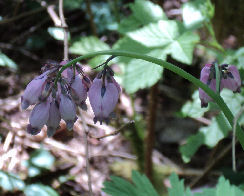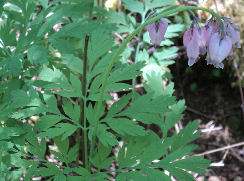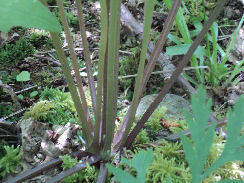|
|
|
|
|
|
| Practical ecological knowledge for the temperate reader. |
Pacific Bleeding Heart - Dicentra Formosa
- Family: Papaveraceae (Fumitory family) (Previously in Fumariaceae) IFBC-E-flora
Description
General Perennial herb.[IFBC][E-flora] "20–45 cm, sometimes glaucous". [Jepson-2]
Flowers Nodding [Foster&Hobbs] inflorescence of 5-15 [IFBC][E-flora] or 3-20 flowers.[HNW] Pinkish-purple [PCBC2004] or rose-pink. "Occasional white flowered
plants are to be expected." [PSW] "Heart-shaped, with flared tips." [WildPNW] 6 stamens, in 2 sets. [Foster&Hobbs]
Fruits Pod-like capsules [IFBC][E-flora] 2-3.5 cm. long. [HNW] The seeds are black and shiny[IFBC] [E-flora] "...with [a] small, white. oil-rich appendage". [PCBC2004]
Leaves The leaves are All Basal [PCBC2004] and long-petioled.[HNW] The leaves are 3-4 times divided [IFBC][E-flora] "into fern-like segments [or "...narrowly oblong ultimate segments." [PCBC2004]], often with a bluish waxy coating." [WildPNW] 2-ternately dissected. [Jepson-2]
Stem Flowering stems leafless. [PCBC2004]
Root Brittle rhizome.[IFBC][E-flora][PCBC2004] Fleshy, scaly rhizomes. [HNW]
Habitat Coastal, meadows, shade, or near large rocks.[WildPNW] "Moist woodlands, forests and streambanks".[IFBC][E-flora] Damp, shaded areas. [Jepson-2]
Range Common in SW BC.[IFBC][E-flora] Locally common. Coastal Washington, Oregon, and Northern California.[WildPNW] "Northwestern California, Cascade Range, High Sierra Nevada, n Central Western California." [Jepson-2]
Status Native.[IFBC][E-flora]
Ecological Indicator Shade-tolerant/intolerant. Western North American. Fresh to very moist, nitrogen-rich soils; "Sporadic to plentiful in the herbaceous understory of young-seral forests on water-receiving sites; most common in broadleaved forests. Occasional in early-seral communities on disturbed sites (burns and clearings). A nitrophytic species". [IPBC][E-flora]
Similar Species
- "Small plants from nw KR with bluish glaucous leaves and light petals have been called subsp. oregana (Eastw.) Munz, Oregon bleeding heart." [Jepson-2]
- Another species found in B.C. is D. uniflora (Steer's Head). It is a native species, found rare E of the coast-cascade mountains. 4-10 cm tall, from a bundle of spindle-shaped fleshy roots. It has a solitary, white to purple flower.[IFBC][E-flora] Steer's head also has "a single 2-spurred flower atop" the stem and it "occurs on gravelly, open, snowmelt-moist slopes at middle to subalpine elevations...mostly east of our region."[PCBC2004]
Hazards
- "May contain alkaloids with CNS-depressant activity". May be toxic or cause skin rash. [Foster&Hobbs]
- "Be careful with young children and animals since all parts of the plant are poisonous. The roots are the most potent. Some people have allergic skin reactions from handling the plants." [Rainyside]
Medicinal Uses
- Plant
- Dosage: HERB. Tincture [1:5, 50% alcohol, 25-50 drops, all to 3X a day. [Moore(1995)]
- Hair: Infusion of crushed plants used as a wash to make hair grow.[Gunther,Erna] [UMDEth][Foster&Hobbs]
- Root
- Dosage: Fresh Root Tincture [1:2], 10-20 drops or applied topically. Dry Root Tincture, [1:5, 50% alcohol] 15-30 drops.[Moore(1995)]
- Anthelmintic: Tea [Foster&Hobbs] or decoction of pounded roots taken as a worm medicine.[Gunther,Erna] [UMDEth][Quattrocchi WDMPP] The decoction can also be "used for kidney ailments, scrofula and skin diseases. [Quattrocchi WDMPP]
- Toothache: Raw roots chewed for toothaches.[Gunther,Erna] [UMDEth][Foster&Hobbs]
Ethnobotany
"...fresh root tincture 1 to 2, in 150 rum, using anywhere from 10 to 30 drops. Internally he has found it effective for the aftermath of accidents, attacks, trauma, especially if the after effect is a continued racing heart or the beginning of an asthma attack. It can be useful for quickly induced depression caused by the former. It breaks the cycle of grief-shock, and allows the person to function....It can also be used topically, though it may take a bit of time to kick in." [herbalistpath]
"Some can be put on cotton ball and inserted it around an abscessed tooth. While the root of yarrow acts much faster, Bleeding Heart goes deeper down the nerve. It can also be used on painful surgical scars as a liniment." [herbalistpath]
Forum Conversations [Various sources. References may not be given]
"...a narcotic-analgesic used for pain and central nervous disorders. Used as a mood-elevating antispasmodic and sedative".(eastbae,Oct 21 08 2:38 AM) [herbs.mxf.yuku]
Pharmacology
Digestive, diuretic and anthelmintic.[Quattrocchi WDMPP]
Phytochemistry
Bicuculline "from species of Corydalis and Dicentra (Fumariaceae) and its quaternary methiodide have been identified as
potent GABA antagonists and have found widespread application as pharmacological probes for convulsants acting at GABA neuroreceptors." [MNP Dewick]
"Cordyline and
bulbocapnine are narcotic alkaloids isolated from ''Dicentra
canadensis and D. formosa'' (Pacific bleedinghearts, used by
the Skagit tribe"'), once known in the northwestern United
States as toothache remedies." [Volansky]
Synonyms
D. formosa var. brevifolia L.F. Hend [Quattrocchi WDMPP]
Dicentra formosa subsp. nevadensis (Eastw.) Munz [E-flora]
Uses of Other Related Sp
"18 species: North America, Asia; some ornamental. (Greek: twice spurred, from outer petals) Other species in TJM (1993) moved to Ehrendorferia (Liden et al. 1997 Plant Syst Evol 206:411–420)."[Jepson] Dicentra spp.; Bicuculline, Metiodine. [Elsevier ASOL]
"Symptoms of poisoning include trembling, agitation, heavy salivation, vomiting, diarrhea, convulsions, tenseness of muscles, difficulty in breathing, and prostration. Recovery is usually rapid and complete.... Members of the genus Corydalis, related to Dicentra, also contain toxic isoquinoline alkaloids." Several Corydalis species are native to North America. "Although not implicated in human poisoning, they have caused poisoning and death in animals." [CPPlantMush] Any part of any species may cause skin irritation with contact. [KYP James]
- Dicentra canadensis - TURKEY CORN (Eastern North American); "This agent was in great repute among very many of our older physicians as an alterative of special value." [Ellingwood] the tubers were useful as food (Yanovsky).[DPL Watts] (E. North America) Medicinally they were used "for menstrual problems, syphilis, and diarrhea." [Foster&Hobbs]
- Dicentra cucullaria - DUTCHMAN’S BREECHES (Canada and U.S.); Dried Tuber - Diuretic and tonic. Has been used for "digestive disorders, urinary tract diseases, menstrual disorders and skin rashes. Formerly it was used for syphilis." Contains "Isoquinoline alkaloids: including bicuculline, corlumine, protopine, cryptopine, cularine".[PDR] "It was used in a Menomini Indian love-charm".[DPL Watts] Alterative; Bitter; Antispasmodic; CNS-Depressant; Diaphoretic; Diuretic; GABAAntagonist; Spasmogenic; Tonic; Toxic. "Bicuculline could cause poisoning in high doses (PH2)." [HMH Duke] "Eating the leaves and root produce poisoning similar to that of bleeding heart" [KYP James]
- Dicentra peregrina (syn. D. pusilla)[Remington USD20] - "a Japanese plant belonging to the Fumariaceae which is used in that country as a folk remedy in dysentery." It contains an alkaloid isomeric with papaverine. "it produces in both cold and warm blooded animals a light narcosis, followed, if the dose be large, by convulsions. It also caused a fall in the blood pressure with slowing of the heart and depression of the respiratory center." [Remington USD20]
- Dicentra spectabilis - Bleeding Heart now under Lamprocapnos spectabilis [ThePlantList-1]; "Isoquinoline-type alkaloids may cause dermatitis". "All parts are toxic; foliage and roots are most toxic". Wash skin thoroughly or "Antihistamines and corticosteroids as needed". [PTH]
References
- E-flora - http://linnet.geog.ubc.ca/Atlas/Atlas.aspx?sciname=Dicentra%20formosa&redblue=Both&lifeform=7
- herbalistpath - Bleedingheart dicentra formosa Pacific Northwest, Angie Goodloe LMT, Herbalist, Friday, March 28, 2008 http://herbalistpath.blogspot.ca/2008/03/bleedingheart-dicentra-formosa-pacific.html
- herbs.mxf.yuku - Dicentra formosa: a relatively unkown "narcotic-analgesic" herb,http://herbs.mxf.yuku.com/topic/4158792/Dicentra-formosa-relatively-unkown-narcoticanalgesic-he#.Vkekw79Wr0w, Oct 21 08 2:38 AM
- Jepson - Gary L. Hannan, 2012. Dicentra, in Jepson Flora Project (eds.) Jepson eFlora, http://ucjeps.berkeley.edu/cgi-bin/get_IJM.pl?tid=22766, accessed on Mar 7 2014
- Rainyside - Dicentra formosa, Rainy Side Gardeners, http://www.rainyside.com/plant_gallery/natives/Dicentra_formosa.html, Nov 14, 2015
- ThePlantList - The Plant List (2013). Version 1.1. Published on the Internet; http://www.theplantlist.org/
- UMDEth - University of Michigan - Dearborn College of Arts, Sciences and Letters - Ethnobotany, http://herb.umd.umich.edu/, Dicentra formosa, Accessed on May 1, 2014
- Gunther,Erna - Gunther, Erna 1973 Ethnobotany of Western Washington. Seattle. University of Washington Press. Revised edition (p. 31)
- Volansky - An Ethnobotany and Oral Hygiene Interplay: A Dental Hygienist Working With the Siletz Indians of Oregon, Mary Ellen Volansky, RDH, MS, SEP-OCT 2010 access
Page last modified on Saturday, December 25, 2021 3:50 AM





